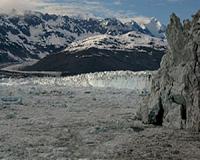| . |  |
. |
New York (AFP) July 16, 2010 When British climbing legend George Mallory took his iconic 1921 photo of Mount Everest's north face, the mighty, river-shaped glacier snaking under his feet seemed eternal. Decades of pollution and global warming later, modern mountaineer David Breashears has reshot the picture at the same spot -- and proved an alarming reality. Instead of the powerful, white, S-shaped sweep of ice witnessed by Mallory before he died on his conquest of Everest, the Main Rongbuk Glacier today is shrunken and withered. The frozen waves of ice pinnacles -- many of them the size of office buildings -- are still there. But they are far fewer, lower and confined to a narrow line. Comparing precisely matched photographs, Breashears determined that the Rongbuk had dropped some 320 feet (97 meters) in depth. "The melt rate in this region of central and eastern Himalaya is extreme and is devastating," Breashears said Wednesday at New York's Asia Society, which is hosting the exhibition (http://sites.asiasociety.org/riversofice/) July 13 to August 15. Amid bad-tempered political debates over the causes and reality of global warming, Breashears speaks literally from the ground. He went in the footsteps of three great early mountaineer-photographers: Mallory, Canadian-born mapping pioneer Edward Wheeler, and Italy's Vittorio Sella, whose work spanned the 19th and 20th centuries. The result is then-and-now sets from Tibet, Nepal and near K2 in Pakistan showing seven glaciers in retreat -- not only much diminished, but in one case having dissolved into a lake. "If this isn't evidence of the glaciers in serious decline, I don't know what is," the soft-spoken Breashears said. The melting glaciers pose more than a threat to the "ultimate harmony" Mallory once described finding in these beautiful peaks. Himalayan glaciers are the world's third largest reserve of ice after the north and south poles, and their seasonal melt water is a crucial source for Asia's great rivers, including the Ganges, Indus, Mekong and Yellow. Asia Society's China expert Orville Schell described Nepal as "a kind of a headquarters for the hydrology of the whole of Asia." As a result, rapid melting is triggering a "cascade of effects all downstream, whether it's animals, plants, rivers, agriculture, people," he said. That interconnectedness also works the other way: fallout from vast smog clouds over Asian population centers is dirtying the seemingly remote glaciers, thereby hastening their destruction. "This black carbon soot then turns the glaciers into kind of a solar collector. Rather than reflecting heat back out of the atmosphere into space, it's absorbing it," Schell said. Addressing the problem requires data and that's proving hard to get, according to Syed Iqbal Hasnain, a top Indian glaciologist who attended the "Rivers of Ice" opening. Hasnain knows first hand about the difficulty of informed debate. He said he was misquoted by a magazine claiming that Himalayan glaciers could disappear by 2035, a terrifying but unfounded prospect which caused uproar after slipping into a UN climate change report earlier this year. Hasnain particularly bemoans the complications of getting authorities and scientists from India, Pakistan, China and Tibet to collaborate in their often hostile border regions. "We should know how much the glaciers are moving," Hasnain said, "but there is a problem of security. NASA wanted to put up some aerial surveys but the government of India said you cannot.... India is so skeptical and they're not coming forward to share the data." Breashears said his photo-climbing expedition was dangerous and exhausting as he searched for vantage points used more than half a century ago. One glacier near K2 required three climbs of 6,000 feet before he found the same view enjoyed by Sella all those years earlier. "We were totally in awe of the people that had been there before," Breashears said. Future generations won't have the same problem because Breashears recorded each spot's GPS coordinates. The question is what will be left to photograph. "You really do have a sense of something we once felt was sort of triumphant in nature now being bested by man," Schell said. "They're kind of on the run, literally moving slowly up the valley."
Share This Article With Planet Earth
Related Links Beyond the Ice Age
 Footloose Glaciers Crack Up
Footloose Glaciers Crack UpSan Diego CA (SPX) Jul 16, 2010 Glaciers that lose their footing on the seafloor and begin floating behave very erratically, according to a new study led by a Scripps Institution of Oceanography, UC San Diego researcher. Floating glaciers produce larger icebergs than their grounded cousins and do so at unpredictable intervals, according to Scripps glaciologist Fabian Walter and colleagues in a paper to be published in th ... read more |
|
| The content herein, unless otherwise known to be public domain, are Copyright 1995-2010 - SpaceDaily. AFP and UPI Wire Stories are copyright Agence France-Presse and United Press International. ESA Portal Reports are copyright European Space Agency. All NASA sourced material is public domain. Additional copyrights may apply in whole or part to other bona fide parties. Advertising does not imply endorsement,agreement or approval of any opinions, statements or information provided by SpaceDaily on any Web page published or hosted by SpaceDaily. Privacy Statement |